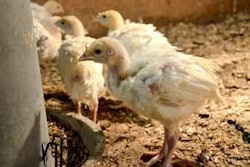Lighting impacts the behavior, growth, and reproduction of poultry. Artificial lighting is extensively used in raising commercial poultry. Incandescent lamps, one of the most common forms of lamps in the United States, are being phased out starting in 2012. This leaves new roles for other lighting technologies, including cold cathode fluorescent lamps (CCFL), compact fluorescent lamps (CFL), and light emitting diodes (LED).
The objective of this project was to determine the reliability, intensity, and floor light patterns of new low wattage light bulbs for use in poultry housing.
In 2007 to 2008, a lighting test apparatus was developed to allow simultaneous rapid durability testing of up to four replications of four lighting technologies. A vacuum sensor cleared the dust from the sensor during testing. All of the incandescent lamps failed during testing, at average of 1,968 hours, well above the manufacturer rated 1,500 hours. In contrast, only one of the cold cathode lamps failed during testing at 3,312 hours. While this represents double the life span of incandescent lamps, the CCFL lamp failed at well less than the 8,000 hours typical for CCFL lamps. Three CFL lamps failed at an average of 2,640 hours well less than the 12,000 hours typical for CFL lamps. No LED lamps failed during testing, which would be expected given the 30,000 hour lifespan typical for LED lamps. Based on durability, CFL lamps do not meet the expectations and should not be used. CCFL lamps showed reasonable durability and are much less expensive than LED lamps.
All of the lamps showed lumen reduction during testing. LED lamps showed significant lumen decline over time, loosing over 60% of the initial intensity. The lumen degradation profiles for CFL and CCFL lamps also showed lumen decline. However, the loss was lower; and after one year of study, decreased to 75% to 81% of their original light output. This means that providing sufficient light throughout the life of the bulb, the lamps will need to be much brighter than minimum requirement.  LED lamps had higher lumen reduction and a longer lifespan, which makes the problem more acute.
All three types of lamps evaluated were more energy efficient than incandescent lamps. CFL lamps showed the greatest savings, using an average of 28% of the energy of incandescent lamps. CCFL (30%) and LED (33%) showed similar energy improvements.





.jpg?auto=format%2Ccompress&fit=crop&h=167&q=70&w=250)










